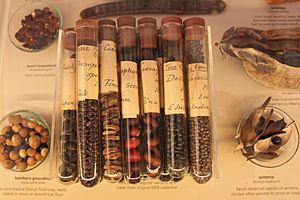Santos Museum of Economic Botany facts for kids

The Museum of Economic Botany
|
|
| Lua error in Module:Location_map at line 420: attempt to index field 'wikibase' (a nil value). | |
| Established | 1881 |
|---|---|
| Location | North Terrace, Adelaide, South Australia |
| Type | economic botany |
The Santos Museum of Economic Botany is a special place in the Adelaide Botanic Gardens. It shows how plants are used in many ways. You can learn about their practical, medicinal, and economic uses. This means how plants help us with everyday items, medicines, and even making money.
Contents
Discover the Santos Museum of Economic Botany
This museum was inspired by a similar one in London's Kew Gardens. The Adelaide Museum first opened its doors in 1881. It is the only museum of its kind left in Australia. When it first opened, it had 3500 objects. These items showed how raw plant materials become finished products we use. Today, the museum displays over 3000 plant samples. This is almost all the material they have collected! The museum also hosts cool art shows sometimes. For example, it featured a photography exhibition in 2018.
What is Economic Botany?
Economic botany is all about how humans use plants. It looks at plants for food, medicine, building materials, and more. This museum helps you understand the amazing connection between plants and our daily lives. It shows how plants are much more than just green things in the garden.
A Look Inside the Museum
The museum was started by its first Director, Richard Schomburgk. He worked with other plant experts from around the world. Together, they gathered many interesting plant materials. You can see things like essential oils, which are used in perfumes and medicines. There are also gums and resins, used in glues and varnishes. You will find fibre plants, which make clothes and ropes. Dyes, food plants, and drinks are also on display. It's a great way to see how plants become so many different things.
Beautiful Building, Important History
The museum building itself is very special. It has a "Greek-revival style" look. This means it was designed to look like ancient Greek temples. It has grand columns and a classic feel. Because of its unique style and history, the museum was added to important lists. It was listed on the Register of the National Estate in 1980. It was also added to the South Australian Heritage Register in 1982. These lists help protect important buildings for future generations.


